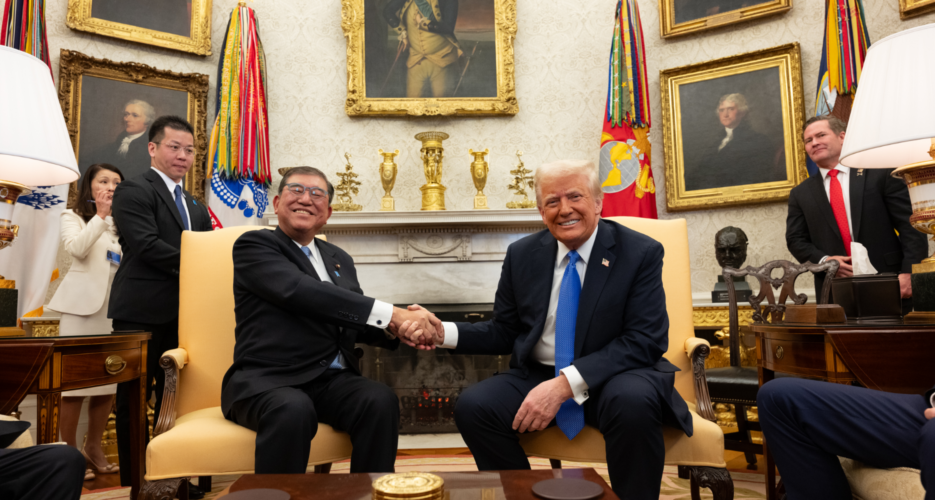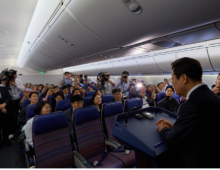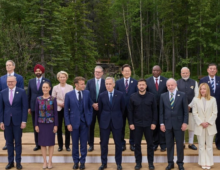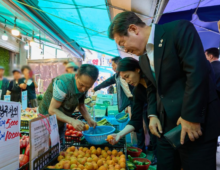|
Analysis Trump and Ishiba tighten US-Japan alliance as South Korea watches on warilyJapan secures stronger security and economic commitments while South Korea risks marginalization amid leadership turmoil John LeeFebruary 10, 2025  U.S. President Donald Trump meets with Japanese Prime Minister Shigeru Ishiba at the White House, Feb. 7, 2025 | Image: White House Japan has decisively positioned itself as the United States’ most important Indo-Pacific ally under President Donald Trump, leaving South Korea in an increasingly reactive position on security, trade and economic strategy. The U.S.-Japan summit between President Donald Trump and Prime Minister Shigeru Ishiba marked a critical shift in regional power dynamics, reinforcing Tokyo’s role as Washington’s top strategic partner in Asia. Japan is expanding its defense cooperation, military integration and economic ties with the U.S. at a scale that overshadows South Korea’s current role in Washington’s Indo-Pacific strategy. While Japan strengthens its influence, South Korea remains politically unstable, with President Yoon Suk-yeol’s impeachment ruling pending and economic uncertainty mounting. This comes as Trump pledged on Monday new tariffs on steel and aluminum, a reciprocal tariff strategy targeting trade surplus nations and pushes for tighter economic cooperation with Japan in artificial intelligence (AI), semiconductors and energy security. As Japan cements its position as the U.S.’ most trusted ally in the region, South Korea faces growing risks of strategic and economic marginalization — a reality that Seoul’s next government will have to navigate in an increasingly competitive Indo-Pacific order.  Two American F-16s, an American B-52H, two South Korean F-15Ks and two 2 Japanese F-2s conduct their first joint air exercise in the overlapping Air Defense Identification Zone (ADIZ) of South Korea and Japan, south of the Korean Peninsula, Oct. 22, 2023 | Image: United States Air Force JAPAN’S GROWING ROLE IN U.S. REGIONAL SECURITY While Ishiba did not mention his long-proposed “Asian NATO” during his talks with Trump, their meeting succeeded in strengthening Japan’s position as a key player in U.S. regional defense strategy, signaling Tokyo’s willingness to assume a greater security role. This reflects a broader U.S. effort to delegate more regional security responsibilities to its allies while maintaining deterrence against China and North Korea. Expansion of U.S. military presence in Japan The U.S. military presence in Japan’s southwest islands will expand under new agreements, enhancing Japan’s role in deterring Chinese military actions in the East China Sea. Trump and Ishiba also agreed to enhance joint command-and-control structures, signaling deeper military integration. However, this development does not fundamentally alter the balance of military coordination between the U.S. and its two allies. South Korea’s Combined Forces Command ensures a high level of operational integration with U.S. forces, while the Nuclear Consultative Group reinforces strategic alignment. U.S. commitment to Japan’s defense and the Senkaku Islands Trump reaffirmed that Article V of the U.S.-Japan mutual defense treaty applies to the Senkaku Islands, reinforcing Washington’s opposition to any attempt by China to alter the status quo. China argues that the islands, which it refers to as the Diaoyu Islands, fall under its territory. With trilateral U.S.-ROK-Japan security cooperation continuing to deepen, South Korean naval forces may find themselves participating in joint military exercises that include scenarios involving the defense of the Senkaku Islands. This could create diplomatic friction with China, which has strongly opposed any moves that it perceives as bolstering Japan’s territorial claims. South Korea’s shifting security position South Korea remains firmly within the trilateral security framework, but Tokyo’s bilateral defense alignment with Washington is deepening, suggesting that Washington increasingly views Japan as its primary Indo-Pacific security partner. Meanwhile, South Korean officials have not yet met with their U.S. counterparts amid the political uncertainty in Seoul and potential future policy shifts under a new government.  Samsung workers present their semiconductors, June 30, 2022 | Image: Samsung U.S.-JAPAN ECONOMIC COOPERATION AND SOUTH KOREA’S CHALLENGES Japan’s $1 trillion investment pledge to the U.S. Ishiba’s pledge to increase Japanese investment in the U.S. to $1 trillion significantly enhances Tokyo’s economic leverage in Washington. The U.S. increasingly views Japan not only as a defense ally but also as a key economic and technological partner, particularly in high-tech sectors such as AI, semiconductors and advanced manufacturing. This raises concerns for South Korea, which has frequently positioned itself as a leading U.S. technology partner. For instance, the Yoon administration was quick to align with the U.S. CHIPS Act and participate in the Indo-Pacific Economic Framework. However, unlike Japan, Seoul has yet to offer a similarly large-scale economic commitment to the U.S., potentially leaving it with less influence in Washington’s future trade and industrial policy decisions. Trump’s steel and aluminum tariffs: Impact on South Korea vs. Japan Trump’s new 25% tariffs on steel and aluminum imports will have disproportionate effects on South Korea compared to Japan. South Korea has been one of the largest exporters of steel to the U.S., and while it previously negotiated export quotas to avoid tariffs under Trump’s first-term trade policies, the latest tariffs could still hit ROK steelmakers harder than their Japanese counterparts. Japan may be in a better position to negotiate exemptions, particularly given the deepening economic and security ties affirmed during the Trump-Ishiba summit. In contrast, South Korea, lacking high-level political engagement due to its leadership crisis, risks being on the receiving end of broader trade restrictions. With the country’s construction sector still struggling to recover, South Korea’s steel industry is dependent on exports and any additional U.S. tariffs may lead to significant decreases in revenue and layoffs. Reciprocal tariffs: How South Korea faces a higher risk than Japan Trump’s reciprocal tariff policy, aimed at countries with trade surpluses against the U.S., puts South Korea at risk of further trade disputes. With South Korea consistently running a large surplus with the U.S., it is a likely target for additional tariffs on key exports such as automobiles, electronics and machinery. While Japan also runs a trade surplus with the U.S., its strategic security commitments and economic investments in the U.S. may give it greater negotiating leverage in tariff discussions. This raises concerns that South Korea could face higher trade barriers without the same level of economic bargaining power. Technology and supply chain competition Japan’s deeper integration into U.S.-led semiconductor and AI supply chains could also sideline South Korea in future trade negotiations. With Washington and Tokyo committing to co-developing key technologies, South Korea risks losing its leverage in shaping supply chain frameworks as Washington prioritizes deeper cooperation with Japan.  Citizens demonstrate in front of the National Assembly for Yoon’s impeachment and the ruling People Power Party’s “legal disbandment,” Dec. 14, 2024 | Image: Korea Pro SOUTH KOREA’S POLITICAL AND STRATEGIC UNCERTAINTY Political vacuum in Seoul amid Yoon’s impeachment ruling With South Korea’s Constitutional Court set to rule on President Yoon Suk-yeol’s impeachment in the coming weeks, the country is facing a leadership vacuum at a critical moment for Indo-Pacific diplomacy. Without a clear government strategy, Seoul risks losing influence in regional security and economic policymaking just as the U.S. and Japan solidify their long-term partnership. Lee Jae-myung’s shifting stance on Japan South Korea’s leading opposition candidate, Lee Jae-myung, recently softened his stance on Japan’s military expansion, a notable reversal from his previous nationalist-leaning positions. For instance, Lee previously opposed military cooperation with Tokyo, stating in 2023 that it could pave the way for Japanese troops on Korean soil. Lee’s sudden reversal suggests that South Korea’s political leadership is already adapting to Japan’s rising influence, but it remains unclear whether a new administration would push for closer cooperation with Japan or pursue a more independent regional policy. THE ROAD AHEAD FOR SOUTH KOREA The Trump-Ishiba summit cemented Japan’s position as Washington’s key in the region, raising significant strategic and economic implications for South Korea. While the U.S.-Japan alliance strengthens, South Korea’s role in regional security and trade policy remains uncertain. With Tokyo and Washington deepening their security and economic ties, South Korea’s next government will need to navigate a regional order increasingly shaped by U.S.-Japan interests. The degree to which Seoul can maintain its influence in both defense and economic policymaking will be determined by how it positions itself in the coming months — a challenge that will only intensify as Trump implements new trade policies and military realignments. Edited by Alannah Hill Japan has decisively positioned itself as the United States’ most important Indo-Pacific ally under President Donald Trump, leaving South Korea in an increasingly reactive position on security, trade and economic strategy. The U.S.-Japan summit between President Donald Trump and Prime Minister Shigeru Ishiba marked a critical shift in regional power dynamics, reinforcing Tokyo’s role as Washington’s top strategic partner in Asia. Get your
|
|
Analysis Trump and Ishiba tighten US-Japan alliance as South Korea watches on warilyJapan secures stronger security and economic commitments while South Korea risks marginalization amid leadership turmoil  Japan has decisively positioned itself as the United States’ most important Indo-Pacific ally under President Donald Trump, leaving South Korea in an increasingly reactive position on security, trade and economic strategy. The U.S.-Japan summit between President Donald Trump and Prime Minister Shigeru Ishiba marked a critical shift in regional power dynamics, reinforcing Tokyo’s role as Washington’s top strategic partner in Asia. © Korea Risk Group. All rights reserved. |











